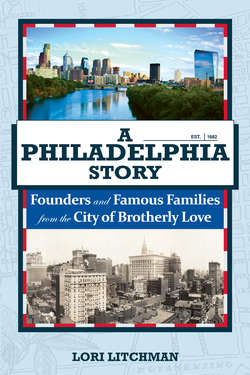Читать книгу A Philadelphia Story - Lori Litchman - Страница 12
На сайте Литреса книга снята с продажи.
Short Stay
ОглавлениеPENN’S FIRST STAY IN THE NEW WORLD was a short one, lasting less than two years. After acquiring Pennsylvania, Penn would spend a great deal of time battling with Lord Baltimore over boundaries. Lord Baltimore claimed that the southern portion of the state—which would have included Philadelphia—belonged to him. Penn met with Lord Baltimore in 1683 to try to settle the dispute of the southern border of the state, with no luck. In 1684, Penn received word that Lord Baltimore was headed back to England to try to establish the southern line of Pennsylvania, so Penn hopped on a boat and headed back to England to fight for his interests against Lord Baltimore. Penn was able to block a transfer of Pennsylvania’s land to Maryland, but he wasn’t able to get the crown to make a decision with regard to the southern border. In fact, the dispute over the southern border of Pennsylvania was not solved in Penn’s lifetime, but rather with the drawing of the Mason-Dixon Line in 1763.
Rittenhouse Square was one of Philadelphia’s original town squares.
(Photo: © M. Edlow/Visit Philadelphia)
During his lifetime, Penn would have two wives and numerous children. His first wife, Gulielma Springett, died before she could make the journey overseas to visit her husband’s colony. She and Penn had eight children, three of whom survived childhood: Laetitia, Springett, and William Jr. Two years after Gulielma’s death in 1694, Penn married Hannah Callowhill, who was 25 years his junior. Together they had eight children, five of whom survived to adulthood: John, Thomas, Margaret, Richard, and Dennis. Only one of those children, John, was born in the New World: Born in 1700, he was nicknamed “The American.”
After securing his property interests in the dispute with Lord Baltimore, Penn returned to Philadelphia in December 1699 with his new wife. When he returned to the colony, he brought with him his secretary, James Logan, who would become an integral part of the growth of Philadelphia and Pennsylvania. During this visit, Penn chose to stay in his country home, Pennsbury Manor. Regardless of his views on freedom, Penn had slaves and allowed slavery in his colony and at his home. (Slavery came to Pennsylvania in the 1640s, thus it had already been established by the time that Penn arrived.) There isn’t much documented about Penn’s slaves, but several of them were named in the historical accounts of Pennsbury Manor, where they lived and served. The known names of Penn’s slaves were Sam, Sue, Yaff, Jack, and Peter.
In 1701, Penn got word that the English Parliament was planning on reclaiming Pennsylvania, so he again boarded a ship and headed back to England to protect his land. He was able to keep Pennsylvania, but he had many financial troubles during the last years of his life. A friend he had entrusted to manage his money ended up stealing from him. Litigation followed and lasted for years before the matter was settled. Penn suffered from a stroke in 1712 and died on July 30, 1718. He was 73 years old and never had the opportunity to return to his beloved Pennsylvania. Even though Penn died a pauper, he left his colony in the care of his sons, John, Thomas, Richard, and Dennis, who hung on to the land until the American Revolution.
During the Revolutionary War, John Penn sided with the American cause. However, the Penn family lost its proprietorship over all of their land and were prohibited from participating in the new government established after the separation from England. The Commonwealth of Pennsylvania paid John, his brother Richard, and a cousin 130,000 pounds. The Penn family was able to hold onto several thousand acres of land across Pennsylvania that were passed down for several generations.
James Logan, Penn’s right-hand man
(Unknown artist; via Wikimedia Commons, public domain)
Leading Ladies: Hannah Callowhill Penn
HANNAH CALLOWHILL PENN was William Penn’s second wife. The two tied the knot in 1696, two years after the death of Penn’s first wife, Gulielma Maria Springett. Hannah was 26 when she arrived in Philadelphia with her husband in December 1699. She was pregnant with the couple’s first child, named John and always referred to as “The American.” She and Penn had eight children together, three of whom died as infants.
Hannah Penn, second wife of William Penn and first woman governor of Pennsylvania
(Unknown artist; via Wikimedia Commons, public domain)
It was Hannah Penn’s ability to manage affairs that became her legacy. In 1712, William Penn became incapacitated by a stroke, making his wife the acting proprietor of Pennsylvania. Hannah managed Pennsylvania from across the Atlantic until her death in 1726. She worked closely with James Logan, Penn’s right-hand man, to help her.
After William Penn died in 1718, Hannah successfully dealt with her husband’s debt, managed his estate, and settled a land dispute with Maryland. Hannah also battled with Penn’s surviving children from his first wife and ensured that her three sons, John, Thomas, and Richard, would inherit Pennsylvania.
In 2014, then-Governor Tom Corbett said it was time to correct history and acknowledge Hannah as Pennsylvania’s first female governor. A portrait of Hannah was commissioned to accompany the portraits of Pennsylvania’s other governors.
When Penn received his charter from the king in 1681, there were only a few hundred people living in the area now known as Philadelphia. By the time of his death, that number had exploded into the thousands. Penn’s “Holy Experiment” would also greatly influence the development of the government of the United States, and Philadelphia would serve as the home base and capital city for years to come.
PHILLY FACT In 1984, during the Reagan administration, an Act of Congress declared William Penn and his second wife, Hannah Callowhill Penn, honorary American citizens.
